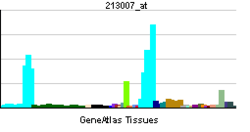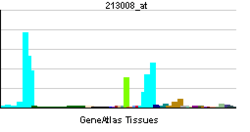FANCI
| FANCI | |||||||||||||||||
|---|---|---|---|---|---|---|---|---|---|---|---|---|---|---|---|---|---|
| Identifiers | |||||||||||||||||
| Aliases | FANCI, KIAA1794, Fanconi anemia complementation group I | ||||||||||||||||
| External IDs | MGI: 2384790 HomoloGene: 49530 GeneCards: FANCI | ||||||||||||||||
| |||||||||||||||||
| RNA expression pattern | |||||||||||||||||
  | |||||||||||||||||
| More reference expression data | |||||||||||||||||
| Orthologs | |||||||||||||||||
| Species | Human | Mouse | |||||||||||||||
| Entrez | |||||||||||||||||
| Ensembl | |||||||||||||||||
| UniProt | |||||||||||||||||
| RefSeq (mRNA) | |||||||||||||||||
| RefSeq (protein) | |||||||||||||||||
| Location (UCSC) | Chr 15: 89.24 – 89.32 Mb | Chr 7: 79.39 – 79.45 Mb | |||||||||||||||
| PubMed search | [1] | [2] | |||||||||||||||
| Wikidata | |||||||||||||||||
| View/Edit Human | View/Edit Mouse |
Fanconi anemia, complementation group I (FANCI) also known as KIAA1794, is a protein which in humans is encoded by the FANCI gene.[3][4][5][6] Mutations in the FANCI gene are known to cause Fanconi anemia.[7]
Function
The Fanconi anemia complementation group (FANC) currently includes FANCA, FANCB, FANCC, FANCD1 (also called BRCA2), FANCD2, FANCE, FANCF, FANCG, FANCI, FANCJ (also called BRIP1), FANCL, FANCM and FANCN (also called PALB2). The previously defined group FANCH is the same as FANCA. Fanconi anemia is a genetically heterogeneous recessive disorder characterized by cytogenetic instability, hypersensitivity to DNA crosslinking agents, increased chromosomal breakage, and defective DNA repair. The members of the Fanconi anemia complementation group do not share sequence similarity; they are related by their assembly into a common nuclear protein complex. This gene encodes the protein for complementation group I. Alternative splicing results in two transcript variants encoding different isoforms.[3]
References
- ↑ "Human PubMed Reference:".
- ↑ "Mouse PubMed Reference:".
- 1 2 "Entrez Gene: FANCI".
- ↑ Nagase T, Nakayama M, Nakajima D, Kikuno R, Ohara O (April 2001). "Prediction of the coding sequences of unidentified human genes. XX. The complete sequences of 100 new cDNA clones from brain which code for large proteins in vitro". DNA Res. 8 (2): 85–95. doi:10.1093/dnares/8.2.85. PMID 11347906.
- ↑ Dorsman JC, Levitus M, Rockx D, Rooimans MA, Oostra AB, Haitjema A, Bakker ST, Steltenpool J, Schuler D, Mohan S, Schindler D, Arwert F, Pals G, Mathew CG, Waisfisz Q, de Winter JP, Joenje H (2007). "Identification of the Fanconi anemia complementation group I gene, FANCI". Cell. Oncol. 29 (3): 211–8. PMID 17452773.
- ↑ Sims AE, Spiteri E, Sims RJ, Arita AG, Lach FP, Landers T, Wurm M, Freund M, Neveling K, Hanenberg H, Auerbach AD, Huang TT (June 2007). "FANCI is a second monoubiquitinated member of the Fanconi anemia pathway". Nat. Struct. Mol. Biol. 14 (6): 564–7. doi:10.1038/nsmb1252. PMID 17460694.
- ↑ Levitus M, Rooimans MA, Steltenpool J, Cool NF, Oostra AB, Mathew CG, Hoatlin ME, Waisfisz Q, Arwert F, de Winter JP, Joenje H (April 2004). "Heterogeneity in Fanconi anemia: evidence for 2 new genetic subtypes". Blood. 103 (7): 2498–503. doi:10.1182/blood-2003-08-2915. PMID 14630800.
Further reading
- Nagase T, Nakayama M, Nakajima D, et al. (2001). "Prediction of the coding sequences of unidentified human genes. XX. The complete sequences of 100 new cDNA clones from brain which code for large proteins in vitro.". DNA Res. 8 (2): 85–95. doi:10.1093/dnares/8.2.85. PMID 11347906.
- Strausberg RL, Feingold EA, Grouse LH, et al. (2003). "Generation and initial analysis of more than 15,000 full-length human and mouse cDNA sequences.". Proc. Natl. Acad. Sci. U.S.A. 99 (26): 16899–903. doi:10.1073/pnas.242603899. PMC 139241
 . PMID 12477932.
. PMID 12477932. - Levitus M, Rooimans MA, Steltenpool J, et al. (2004). "Heterogeneity in Fanconi anemia: evidence for 2 new genetic subtypes.". Blood. 103 (7): 2498–503. doi:10.1182/blood-2003-08-2915. PMID 14630800.
- Ota T, Suzuki Y, Nishikawa T, et al. (2004). "Complete sequencing and characterization of 21,243 full-length human cDNAs.". Nat. Genet. 36 (1): 40–5. doi:10.1038/ng1285. PMID 14702039.
- Bouwmeester T, Bauch A, Ruffner H, et al. (2004). "A physical and functional map of the human TNF-alpha/NF-kappa B signal transduction pathway.". Nat. Cell Biol. 6 (2): 97–105. doi:10.1038/ncb1086. PMID 14743216.
- Brandenberger R, Wei H, Zhang S, et al. (2005). "Transcriptome characterization elucidates signaling networks that control human ES cell growth and differentiation.". Nat. Biotechnol. 22 (6): 707–16. doi:10.1038/nbt971. PMID 15146197.
- Gerhard DS, Wagner L, Feingold EA, et al. (2004). "The status, quality, and expansion of the NIH full-length cDNA project: the Mammalian Gene Collection (MGC).". Genome Res. 14 (10B): 2121–7. doi:10.1101/gr.2596504. PMC 528928
 . PMID 15489334.
. PMID 15489334. - Beausoleil SA, Villén J, Gerber SA, et al. (2006). "A probability-based approach for high-throughput protein phosphorylation analysis and site localization.". Nat. Biotechnol. 24 (10): 1285–92. doi:10.1038/nbt1240. PMID 16964243.
- Ewing RM, Chu P, Elisma F, et al. (2007). "Large-scale mapping of human protein-protein interactions by mass spectrometry.". Mol. Syst. Biol. 3 (1): 89. doi:10.1038/msb4100134. PMC 1847948
 . PMID 17353931.
. PMID 17353931. - Smogorzewska A, Matsuoka S, Vinciguerra P, et al. (2007). "Identification of the FANCI protein, a monoubiquitinated FANCD2 paralog required for DNA repair.". Cell. 129 (2): 289–301. doi:10.1016/j.cell.2007.03.009. PMC 2175179
 . PMID 17412408.
. PMID 17412408. - Dorsman JC, Levitus M, Rockx D, et al. (2007). "Identification of the Fanconi anemia complementation group I gene, FANCI.". Cell. Oncol. 29 (3): 211–8. PMID 17452773.
- Sims AE, Spiteri E, Sims RJ, et al. (2007). "FANCI is a second monoubiquitinated member of the Fanconi anemia pathway.". Nat. Struct. Mol. Biol. 14 (6): 564–7. doi:10.1038/nsmb1252. PMID 17460694.
This article incorporates text from the United States National Library of Medicine, which is in the public domain.